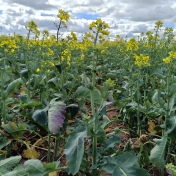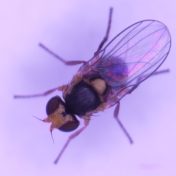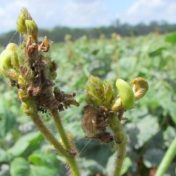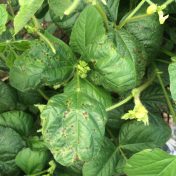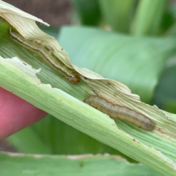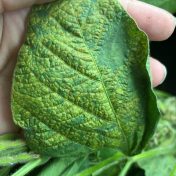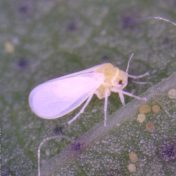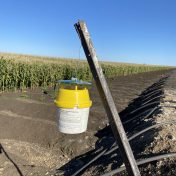More growers are planting canola in southern Queensland this season, so it’s important to be on the lookout for turnip yellows virus (TuYV) – one of the main viral threats to canola. What is TuYV and why does it matter? TuYV is a persistent virus that affects canola and other brassica crops. It is transmitted by green peach aphids (GPA,… Read more »
As we approach the end of the mungbean season in southern Queensland, there have been several reports of pest fly infestations in mungbean crops, including bean fly (Ophiomyia phaseoli) attacking later stage crops, along with infestations of the relatively recent invader the American serpentine leaf miner (Liriomyza trifolii). Late bean fly infestations Late bean fly damage was recently observed in… Read more »
QDPI entomologists have received several recent reports of poor control after spraying bean podborer (Maruca vitrata) in Central Queensland mungbean crops. A major pest of mungbeans in tropical and subtropical production areas, bean podborer is typically more problematic in coastal cropping regions and can be more difficult to manage than co-occurring Helicoverpa sp. populations. Infestation pattern and nature of damage… Read more »
Powdery mildew is a fungal disease that is commonly seen each cropping season in most mungbean paddocks in Australia. In Queensland and northern New South Wales, disease outbreaks usually occur from early autumn in the summer planted crops, with epidemics typically developing as soon as temperatures drop. Initial symptoms are easy to recognise: small whitish, powdery spots on the upper… Read more »
A wet spring has led to outbreaks of halo blight in several spring-planted mungbean crops throughout southern Queensland. Tan spot has also been detected in some crops. Avoid replanting seed from crops affected with halo blight and tan spot and minimise the spread of these diseases by restricting access and ensuring good farm hygiene. Avoid movement through infected paddocks and… Read more »
Native armyworm species are currently present in many young maize and sorghum crops across southern and central Queensland. Sometimes it is just the occasional larva, but in other situations native armyworms are at higher densities than fall armyworm (FAW). As far as we know, native armyworm are far less damaging to establishing crops than FAW and are unlikely to cause… Read more »
Earlier this year, the Queensland Department of Primary industry (DPI) pathology team received samples of soybean with virus-like symptoms. Diseased plants displaying strong chlorotic mottle on leaves and leaf crinkling (see images below) were scattered through the crop. While the samples tested positive in a polymerase chain reaction (PCR) test for potyvirus, the actual species remained a mystery. Subsequent sequencing… Read more »
The biggest challenge when storing grain is dealing with insects (such as weevils) and prevention is ALWAYS better than cure. Controlling insects once they infest grain can only be done with fumigation or controlled atmosphere, both of which require gas-tight sealable storage. For storages that cannot be sealed, prevention is our only management option, short of transferring grain out via… Read more »
As part of the cotton industry’s proactive approach to managing resistance risks, there is an ongoing program of resistance surveillance in the major pest species. Resistance to spirotetramat (Movento®) was first detected in silverleaf whitefly (SLW) in the Burdekin region in 2016. From 2016–2024, 131 SLW populations have been collected and tested for resistance to spirotetramat, 4 populations were from… Read more »
The Field Crops Entomology Team at the Queensland Department of Agriculture and Fisheries has recently established a new moth pheromone trapping network to inform the northern grains industry of the seasonal population patterns of key caterpillar pests. A collaborative network of more than 25 growers and agronomists are assisting the monitoring of pheromone traps in 20 locations across 10 regions…. Read more »
